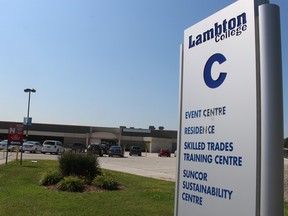
Lambton County Science Fair organizers are calling for competitors as they work to rebuild pandemic-related participation.
Advertisement 2
Article content
The fair, run by local volunteers, drew 94 entries in 2019, the year before COVID-19 restrictions began. Last year, there were 37 entries.
Article content
The fair was canceled for one year during restrictions and then moved online before returning to an in-person event.
“We’re still a long way from where we used to be,” said Peter Smith, an organizer. “It’s a question of trying to build things up again.”
This year’s fair for pupils and students in Grades 3 through 12 will be held April 5 and 6 in the Lambton College Event Center ballroom. Past fairs were staged mostly in the college gym.
Registration is open at lambtoncountysciencefair.ca until March 28 at 5 p.m.
Smith said organizers are spreading the word about the fair, which was incorporated 51 years ago, in hopes of drumming up interest.
Advertisement 3
Article content
Projects will be judged in four different age categories: exhibition for Grades 3 to 5; junior for Grades 6 to 8; intermediate for Grades 9 and 10; senior for grades 11 and 12.
Top finishers receive certificates and cash prizes, with the best intermediate and senior projects advancing to the Canada-Wide Science Fair.
Lambton students have done well in the past in national and international competition.
That includes Sarnia’s Annabelle Rayson, now studying at Harvard, who won nationally and placed third at the European Union Contest for Young Scientists in the Netherlands. She also won the 2022 Stockholm Junior Water Prize in Sweden.
One attraction of taking part in the annual science fair is the chance to carry out personal research, Smith said.
Advertisement 4
Article content
“They pick a subject that interests them, and they want to learn about,” he said. “They design what they’re going to do, how they’re going to experiment, how they’re going to collect data.”
They also decide “how they’re going to tell the story” about what they’ve found, Smith said.
Judges look at how students develop their idea, “where they take it and how they apply scientific principles to what they’re doing,” he said.
The science fair lets young people feel “pride in research,” and learning how to explain their projects to judges and others, Smith said.
Organizers often see the confidence of “very shy” young participants build as they take part, he said. “By the time they leave, they’re excited and . . . looking forward to doing it again.”
It’s also an opportunity to young people to learn about the responsibility needed to complete a project on time, Smith said. “It teaches them to be diligent.”
The annual fair is supported by local donors and sponsors.
“We do have to raise about $25,000 each year,” Smith said. “We’re very lucky that we’ve got some very supportive industries here.”
Article content
